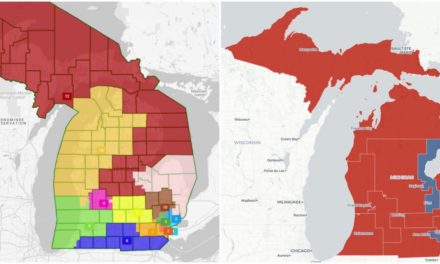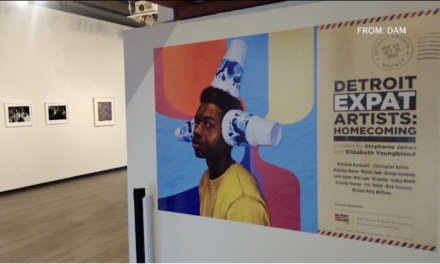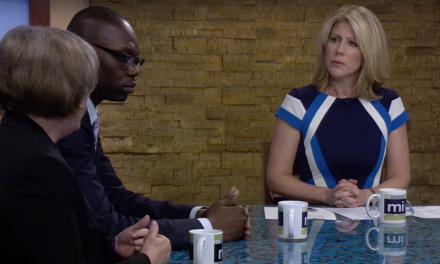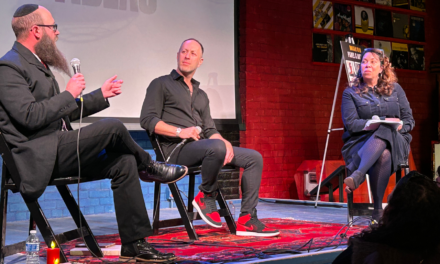Dedicated to documenting and sharing Arab American stories, history and culture, the Arab American National Museum in Dearborn, Michigan is the only museum of its kind in the United States. For Arab American Heritage Month this year, the museum is offering free admission to visitors, as well as a dance performance choreographed by the museum’s artist-in-residence.
One Detroit sat down with Arab American National Museum Director Diana Abouali to learn about the four permanent exhibits at the museum, which share Arabs’ contributions to the world, the phases of Arab immigration to the United States, the creation and growth of Arab American culture, and the individual Arab Americans who’ve made an impact on science, art, politics and more.
“We’re trying to fill in the gaps of an incomplete narrative,” Abouali said.
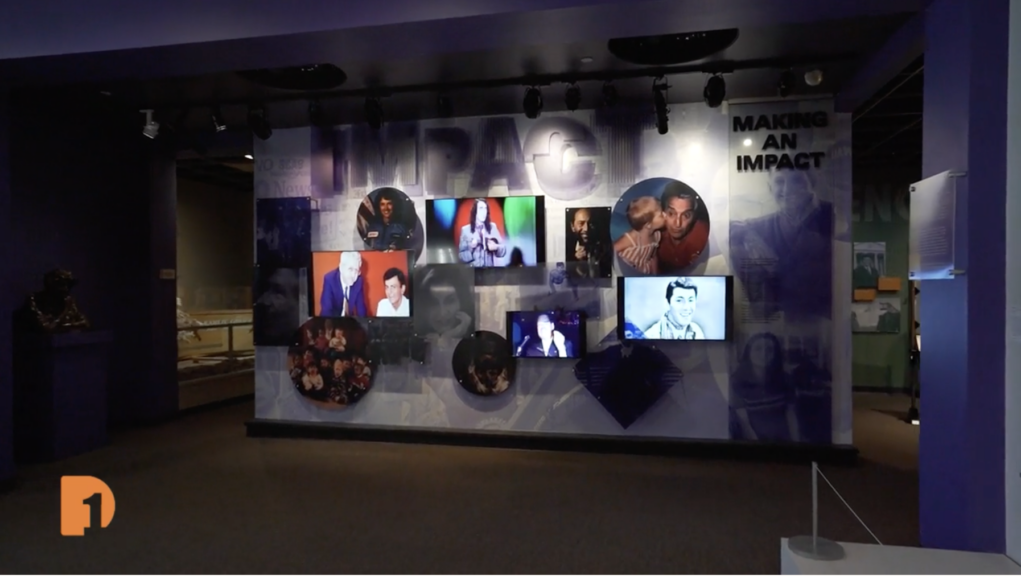
One of the four core exhibits at the Arab American National Museum is titled “Making an Impact,” showcasing prominent Arab Americans in the arts, sciences, politics and more. | Photo by One Detroit
Abouali also talks about the importance of showcasing emerging Arab American artists through the museum’s artist-in-residence program, and she unveils the museum’s plans for an heirloom garden on the museum’s third-floor terrace, set to open in 2023. The garden will highlight the spiritual practices and rituals around gardening in the Arab world.
Plus, the museum’s artist-in-residence, choreographer Leila Awadallah, talks about her dance performance, titled “Terranea: hakawatia of the sea,” with her dance group Body Watani — “watani” translates to “homeland” in Arabic. The performance will explore what our bodies know and carry with us about past generations and our ancestral homelands.
Full Transcript:
Diana Abouali, Director, Arab American National Museum: People should come to the Arab American National Museum because they will get a sense of a chapter of American history that isn’t told anywhere else. We’re trying to fill in the gaps of an incomplete narrative. For Arab American Heritage Month, we offer free admissions all month and we urge everyone to take advantage of it.
The Arab American National Museum is the only museum of its kind in the United States. We present and share stories about Arab Americans, their history, their culture, and being the only institution of its kind in the country. I think we have a great responsibility to be very thorough in the way that we tell and share these stories. We let objects sometimes speak for themselves, but there’s also a narrative that we’re saying we’re telling the history of Arab immigration to the United States.
We’re showing how Arabs, once they came to the United States, how they sort of created a life for themselves here, how they engage with the society and through various aspects and sectors. But we also use art as a way of showing that there is a vibrant and active creative community, in the Arab-American community. So, the permanent exhibits are the core galleries, as we call them. We have four of them. The first one, which is in what we call the courtyard, sort of tells the history of Arab contributions to world civilizations.
There’s a lot of contributions in terms of science, of mathematics, art, architecture. So, we try to set the scene in this first-floor courtyard. On the second floor is where we tell the history of Arab immigration to the United States. So, we have a gallery called ‘Coming to America’, where we talk about the various phases of immigration. The next gallery is called ‘Living in America’, and that’s where we look at what is Arab-American culture like? And then the final permanent gallery that we have is called ‘Making an Impact’, where we sort of showcase and shed a spotlight on Arab-Americans who have made an impact on this country in the various sectors.
Whether creative arts, politics, entertainment, literature, what have you. In the temporary exhibits, what we do is they’re mostly exhibits of artwork by Arab-American artists. And again, that’s where we kind of show how Arab-American artists today kind of interpret the world around them. So, we are planning to open a rooftop garden. We have a terrace on the third floor and that will be what we call an heirloom garden. So, it’s to sort of talk about and show how the Arab community here, like many other Arab immigrant communities, have brought plants or seedlings or seeds from their hometowns and cities, and planted them here in the United States. And to talk about that sort of practice and rituals around gardening and sort of putting in roots in a new home. So, that will happen and the opening will be in June when the.
Diana Abouali: We are very keen to give a platform for Arab-American artists. We have an artist residency program that I believe is one of the only of its kind in the country as well, where we try to support as much as possible emerging young, usually starting emerging artists, giving them some financial assistance, a space to work, and an opportunity to showcase their work as well.
Leila Awadallah, I find a very special artist, dancer, choreographer. We have a conference called MOVE, which is run by Access, our parent organization. And as part of that conference, we have a performance by Leila Awadallah called TERRANEA. And I believe it’s iabout sort of the Mediterranean Sea as a kind of crossroads for for for immigrants.
Leila Awadallah, Choreographer & Artist-in-Residence, Arab American National Museum: I’m very interested in researching ideas about contemporary Arabic dance forms and what that might mean to look at rooting specific movement or ideas in the Arab world, but then also exploring them in more contemporary or experimental dance choreographies. For me, choreographing or dancing is also really deeply related to my love for Palestine and my people, and what it means to speak out about Palestine issues and Palestine realities, and let that initiate a conversation with audiences and with artists. The performance on April 28th is called, TERRANEA: Hakawatia of the Sea.
It’s a dance performance about the Mediterranean Sea, both as a mythological space where so many mythologies have been told about that water, but also as a sight of loss. The Mediterranean Sea is a space for grieving. There’s always, every day life lost in the sea. It’s also about the land and what it feels like to be next to the sea and the ways the land and water converse in our bodies and in our dances.
So, our project is called Body Watani Dance Project. Watani means my homeland in Arabic. So, our dance project explores what is home in our bodies. This is a performance that I would love to invite everyone to, to share that moment, to share that time where we think about, you know, what to our bodies, know about our home and our generations, and what kind of stories from our grandmothers live inside of us.
Diana Abouali: It’s a great way and a great gateway into learning about this community, what they’ve done, what they’ve accomplished, their culture. And I think if you’re new to Dearborn, using the museum as a sort of stepping stone to discover the rest of Dearborn would be a great way to do it.
Stay Connected:
Subscribe to One Detroit’s YouTube Channel & Don’t miss One Detroit Mondays and Thursdays at 7:30 p.m. on Detroit Public TV, WTVS-Channel 56.
Catch the daily conversations on our website, Facebook, Twitter @DPTVOneDetroit, and Instagram @One.Detroit
View Past Episodes >
Watch One Detroit every Monday and Thursday at 7:30 p.m. ET on Detroit Public TV on Detroit Public TV, WTVS-Channel 56.

